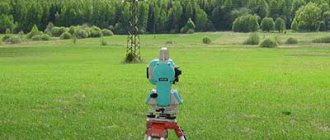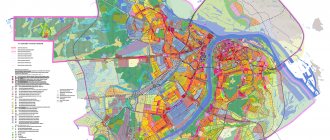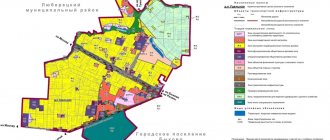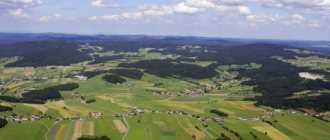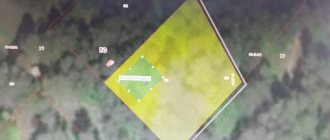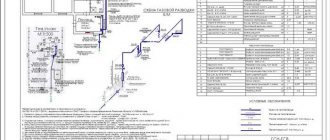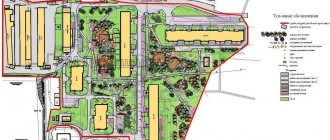The name of single land use was given to a type of allotment divided by public areas or social facilities. That is, this is the name given to plots consisting of several pieces of land. And each of them has a personal cadastral number. They also have separate contours.
Dear readers! Our articles talk about typical ways to resolve legal issues, but each case is unique. If you want to find out how to solve your particular problem, please use the online consultant form on the right or call. It's fast and free!
What it is
The concept of single land use refers to areas with a cadastral number, consisting of two or more other areas. Each of the plots has its own contours and cadastral numbers. Their sizes are combined together when a single land use is formed.
Regulation at the legislative level
The use of the term suggests that there are several separate areas of land that form one larger one. Each of these plots has its own boundaries with a personal cadastral number. The same applies to geodetic data. But there are situations when geodetic data is combined.
Land plots of this group are divided into two types:
- The usual distinction.
- Conditional type boundaries.
The main difference between these types is in determining the location for the contours. Conditional land plots are characterized by the absence of clear contours.
Such lands are adjacent to other objects that are not considered part of a single land use. It was this reason that contributed to the assignment of the name adjacent to conditional plots.
Assignment of the status of single-use land is most often organized for gardening associations and partnerships. They often own groups of plots that are separated from each other. But they are part of the same group.
The procedure is very simple. Characteristically, those who are interested in determining the status of sites have no problems.
The main thing is to use the right concepts. Since 2007, the concept of multi-circuit sections has been added to use. Each type has its own legal basis. Only the accounting system remains approximately the same for everyone.
Termination of unified land use
To resolve disagreements in the regulatory sphere, it is carried out with the help of various regulations (orders on the division of land, cadastral number and other documents). This legal regulation is carried out in the field of state registration of land plots. As a rule, various legal instruments are used for legal regulation in the field of land use. State Law No. 221 is one of the legal instruments for regulation in the field of electronic health.
Today, EZ status is not assigned , since state law No. 221 came into force in 2007, according to which the concept of multi-circuit sections was introduced. Today this status is an alternative to EZ. Consequently, EZ status was assigned to lands until 2007. Land plots that fell under the definition of Unified Land Use were not transformed until 2007. Therefore, today they fall under this status.
Formation: methods, description of order
Now the formation of unified land use has been stopped. Areas with this status were formed earlier, before 2008. Then the term multi-circuit sections began to be widely used. The rules for such objects are described in detail in Federal Law No. 221.
A multi-circuit section is formed when it is necessary to combine two or more sections with closed contours.
Formations are different.
- Interspersed. These are objects between which there is land that is not related to this association.
- With split type circuits. These types of lands are adjacent to each other. But they have their own contour.
Currently, only multi-path creation is available. One of the ways to create it is to separate it from a single land use.
Territory zoning map.
What rules are used to clarify unified land use?
The so-called clarification of unified land use is required in several situations. During this procedure, the actual data is compared with what is available in the registration registry. Refinement is most often required to create new objects. Or to more accurately determine the boundaries of those that already exist.
The process also involves the creation of a detailed boundary plan. It contains information about areas that are already in use. The results of the procedure are the reorganization of plots or the introduction of changes to registration documents.
The most successful method of clarification in the case of unified land use is considered to be special-purpose computer programs. Thanks to such programs, there are as few problems as possible when creating a boundary plan.
Each such program has a user-friendly interface. In which only a few types of data are entered.
- Plot numbers from the cadastre.
- Information about how many areas require clarification.
- Information on the presence or absence of newly formed areas, along with a description of the coordinates.
- Link to cadastral number of objects.
- Other information that relates to a particular object.
The program itself draws up a boundary plan after all the lines are filled in. But you can also create a plan using regular tables in Excel. Specialized software is considered more accessible.
Clarification of unified land use in the program “Polygon: Boundary Plan”
When drawing up a boundary plan to clarify a single land use, many questions and doubts arise. In this article we will show how to create a boundary plan to clarify a single land use with the inclusion of newly formed areas with clarification of adjacent areas. As a tool, consider the program “Polygon: Land Survey Plan”
, with the help of which you can quickly and easily create a boundary plan of any complexity.
Computer program “Test Range: Land Survey Plan”
serves to automate the filling out of a boundary plan - documents and drawings for registering land plots with cadastral registration with the generation of both printed and electronic documents (XML files), as well as the creation of a ZIP archive for submission to the cadastral registration authority or sending it from the program to Rosreestr.
The program is developed in accordance with the following regulatory documents:
- Order of the Ministry of Economic Development of Russia No. 412 dated November 24, 2008. “On approval of the form of the boundary plan and requirements for its preparation, an approximate form of notice of a meeting to agree on the location of the boundaries of land plots” as amended by Order of the Ministry of Economic Development of Russia No. 32 dated January 25, 2012.
- An XML schema used to generate an XML document - a boundary plan of a land plot, submitted to the cadastral registration authority in the form of an electronic document. Approved by Order of Rosreestr dated June 25, 2013 No. P/237. Version 04 (versions 03 and 02 are also supported).
The program allows you to draw up boundary plans for all types of cadastral actions provided for in the form of a boundary plan: formation of land plots [1] by division, allocation, redistribution, consolidation, formation of land plots from lands, formation of parts of land plots, clarification of land plots, clarification of the boundaries of adjacent land plots, correction cadastral error.
The program works both with ordinary land plots (land uses), and with plots that are part of the EZ [2] (separate, conditional plots), multi-circuit land plots, incl. with areas that have internal boundaries.
Working in the “Polygon: Boundary” program you can get:
- electronic document of the boundary plan (XML file);
- printed forms of documents;
- A ZIP archive containing all submitted files: XML, application files[3], as well as their electronic signatures.
The program creates all these documents automatically based on the entered initial data. The XML document and the generated ZIP archive are checked for correctness of completion, as well as for compliance with the Order and the approved XML schema.
In "Polygon: Boundary Plan"
It is possible to send a boundary plan to Rosreestr directly from the program.
Before we begin to consider the boundary plan, let us recall how a single land use differs from a multi-circuit plot. In the State Land Cadastre, it is customary to define a single land use as a composite land plot, which is assigned a single cadastral number, and which consists of two or more separate land plots, which also have their own cadastral numbers.
Multi-circuit land plot
- this is a land plot, the boundary contour of which consists of 2 or more closed contours. A multi-circuit memory unit is assigned only one cadastral number. According to clause 89 of Order No. 412 of the Ministry of Economic Development, the designation of the contour of a multi-circuit land plot is given in the form of a designation (or cadastral number) of the land plot and a number enclosed in brackets - the serial number of the circuit, written in Arabic numerals, for example, 19:01:010203:123(1), 19:01:010203:124:ZU1(1), :ZU1(1).
The program is controlled using the toolbar, and the current action that the program is performing and the result of its completion are displayed in the status line. The information panel displays a hint about the item from the Order corresponding to the field being filled in.
The boundary plan consists of sections. Each section is presented in the program with a separate tab. Sections that are mandatory are immediately available for completion. To add a new section, there is a button on the toolbar - “Add section”
.
Rice. 1. Main window of the program “Polygon: Boundary plan”
We will show you how to create a boundary plan in the “Polygon: Boundary Plan” program using the new XML schema version 04. To select the desired version of the scheme, click on the button – “Change XML Schema Version”
.
Let's start filling out the information from the “Title Page” section. Fill in the required field “! 1. The boundary plan was prepared as a result of the implementation of cadastral work in connection with"
(required fields are marked with a “!”), we will enter information about the customer, information about the cadastral engineer, which are filled out in a separate form that opens when you click on the “Fill” button, then fill in the details
“*Date of cadastral work”
. The program will remember information about the cadastral engineer for the next land survey plan.
The source data must be entered on the “Source” tab. We enter the documents on the basis of which the boundary plan was drawn up in table “1. List of documents used in drawing up the boundary plan.” The list of these documents can be copied to the “Contents” tab; to do this, place the cursor in the “Appendices” table and click on the “Calculate/Fill”
.
Fig.2. Section "Initial data"
To clarify the boundaries of land plots that are part of a single land use, we will add a section “Clarified”
.
1. Let’s fill out the first tab “To be specified” directly for the single land use as a whole. It is necessary to indicate the cadastral number in the field “Cadastral number of the land being specified”, the cadastral quarter, the area and the error of the unified land use. In our example, newly formed areas are included in the ED, so we will enter (or import) their points into the table with coordinates. If the formed areas have parts, we will indicate the coordinates of the parts. To fill in information about parts of boundaries, click the button – “Calculate/Fill”
.
Rice. 3. Tab “To be specified”, filled in on the EZ
At the bottom of the window you need to check the box “*Upload to the branch “Composition of a single land use” (ExistEZParcels)”. If the composition of a single land use does not change (but only the coordinates of the points of previously existing areas included in the EZ are specified), then tables “a)*Information on existing isolated and conditional areas included in the EZ”, “b)*Information on new isolated and conditional sections included in the EZ” and “c)* Incoming sections excluded from the EZ” do not need to be filled out. In our example, it is necessary to fill out the table under the letter b), which is filled in automatically using the “Calculate/Fill”
.
“Refinable” tabs
, how many separate (conditional) land plots that are part of the EZ need to be clarified. On each such tab, information about one separate (conditional) land plot is filled in: the indicated cadastral number, cadastral number EZ and other information. On these tabs, the “*Upload to the branch “Composition of a single land use” (ExistEZParcels)” should not be checked.
Fig.4. Tab “Refined” for a separate (conditional) area
Information about the EZ and the plots included in it can be imported from the cadastral extract of the land plot (in the “Open” button menu, select the “Import information from XML file...” command). As a result, many details of this tab will be filled in, including existing coordinates, boundaries, cadastral number and more.
Fig.5. Open button menu
In our example, newly formed land plots must be “cut out” from areas adjacent to the same land use, i.e. add internal boundaries to adjacent memories. For each adjacent land plot, fill out the “Updating” tab, where you need to check the box “Upload this section as information about clarifying the border of an adjacent land plot,” and also enter the cadastral number of the adjacent plot and other necessary information.
Fig.6. Tab “Refined” for an adjacent area
Select in the field “*Type of clarification of adjacent area”
from the list the value “Changing part of the border (from point to point), including adding an internal border (“hole”)” and in the table with coordinates we indicate the coordinates of only the internal border being added in the specified X, Y columns.
If necessary, fill out such sections of the boundary plan as “Information on measurements and calculations performed”, “Conclusion of a cadastral engineer”, “Act of approval of the location of the border of the land plot” and others.
Graphic sections of the boundary plan can also be quickly prepared in the “Polygon: Boundary Plan”
, for this:
- It is necessary to transfer the coordinates of points from the text sections of the plan to the graphic using the button – “Calculate/Fill”
. - Next, symbols, line types, and colors are selected. You can select the same color or sign by simply copying it in the table.
- In the diagram, you can show additional connections between points; for this, in the 2nd table, select the starting and ending points that need to be connected, the type of line, and to sign the distance in the “Sign distance” column, put “+”.
- To add a raster background to the “Open” button menu, perform “Insert raster from file”.
- Calculate the scale of the drawing ( – "Calculate/Fill"
).
Rice. 7. Tab "Drawing"
Using the button – “View graphics”
you can see the drawing. When viewing a drawing, you can select points, lines, and change their symbols.
Fig.8. View a drawing
According to the XML scheme version 04, in the “Drawing” section it is necessary to fill out the table “!* Attached files with images”, to do this, print the drawing and save it in pdf format (jpg, tiff), enter the file name in the specified table.
After all the steps have been completed, all that remains is to fill out the “XML” tab for the electronic document. We add the “XML” section; this section can be included in the boundary plan only in one copy. If it is not enabled, then uploading to an electronic document will not be performed. In this section, you must specify “!Type of information” - in our example, we will select “package of information with a statement of changes.” Check the box “Include digital signature files in the ZIP archive.”
Fill out the table “Attach files to a ZIP archive”
: for XML scheme version 04, click on the button -
“Calculate/Fill”
- the program will enter into the table the files specified on all other tabs of the boundary plan (for example, files of scanned documents), and for scheme 03 - manually select the files that will be attached in a ZIP archive.
Fig.9. "XML Upload" Tab
Creating an XML file of an electronic document
– click the button –
“Upload to XML”
– an XML file editor window will appear and a message indicating that the electronic document has been generated and saved.
Rice. 10. XML File Editor
If errors were detected during the formation of the XML file, the error and warning log window will open. Any errors found in the boundary plan must be corrected and the XML file regenerated.
Fig. 11. Error and warning log
Working with electronic signature (ES).
The “Polygon: Land Survey Plan” program signs files
with an enhanced qualified
electronic signature in accordance with the standards of Rosreestr and in accordance with Federal Law No. 250 of July 23, 2013 “On amendments to certain legislative acts of the Russian Federation regarding state registration of rights and state cadastral registration of real estate objects,” therefore additional no software required. All you need is an electronic signature key and a program containing Russian signature standards, for example, CryptoPro CSP.
All boundary plan files can be signed with one button: click – “Sign all”
, then select the signing certificate in the dialog window, after which the program will inform you that the files were successfully signed.
Creating a ZIP archive.
The ZIP archive is created according to the requirements of Rosreestr, specified in the order of Rosreestr dated June 25, 2013 No. P/237.
Click on the button – “Create ZIP archive”
. Upon completion, the program will offer to save the resulting ZIP file to removable media, or open the folder in which it was created. If any errors occurred during archive creation, an error log will be displayed on the screen.
Currently, the program has a unique opportunity to send boundary plans directly to Rosreestr. To send, you do not need to fill out a form on the Rosreestr website, or attach files, etc. – just click on the “Send”
. The results of processing the registration application can also be seen directly in the program.
In this article, we tried to briefly describe the most significant features of the “Polygon: Land Survey Plan” program. You can learn more about the program using the demo version of the program, which can be downloaded on our website.
In conclusion, I would like to add that “Polygon: Boundary Plan”
– the program is flexible and universal, and creating boundary plans of any complexity using this program is a fairly simple and fast process. If any difficulties arise, technical support specialists will always help you both in working with the program and in creating boundary plans.
[1]ZU – land plot
[2]EZ – single land use
[3]Attached files can be in *.jpg, *.pdf, *.tiff formats in accordance with Order of Rosreestr dated June 25, 2013 No. P/237.
| Go to Polygon Pro → |
| Program catalog → |
About boundary plans for plots
A cadastre number cannot be assigned to a land plot if a boundary plan has not been drawn up for it. This document contains all the information regarding certain objects on earth.
Typically, boundary plans contain two parts.
Text. With all the data that is entered into the cadastre itself. And also with information on agreeing on the location of the site boundaries.
Graphic. Gives a more detailed idea of where the site is located.
In the following situations, it is necessary to draw up only one copy of the boundary plan.
- If several plots are formed, which is why clarification of the available data is required.
- It is necessary to clarify the information about the location of the site along with its boundaries.
- Formation of several plots from one multi-circuit plot.
- The formation of an allotment coincides with the need to clarify information about other objects.
- Simultaneous formation of an allotment with its other parts.
- Several plots are formed by allocating shares from the common property.
- Redistribution of several plots at once.
- Dividing one plot into several small territories.
Rules for drawing up boundary plans for a multi-circuit section
Milestone plans consist of such components as: a list of applications; The grafical part. Here you need to provide location diagrams along with geodetic data. And drawings of any objects occupying the territory. The division of the site should also be reflected in the plan.
In addition, there is a part in the form of text, contents with a title page.
The boundary plan must contain additional information if a multi-circuit plot was formed by combining several objects into one. It is necessary to talk about the areas through which access to this place is obtained; about the formed plot itself along with its territory; source data.
The main thing is that the multi-circuit section itself complies with the requirements of current legislation.
Section of a multi-circuit land plot
The division of an existing multi-circuit land plot into new separate land holdings is a fairly responsible procedure, which includes the following steps:
- Clarification of the status of a land plot - to do this, it is necessary to take the unique cadastral number of the plot from the certificate of state registration of property rights (land certificate) and, using the appropriate Internet services, check the correct placement of its contours on the map;
- Collection of documents - for the division of a multi-circuit plot, before its surveying, documents such as the written consent of the owner of the plot for its division, a certificate of state registration of property rights and a cadastral passport of the plot are transferred to the organization engaged in this type of work.
- Land surveying - at the request of the owner, a specialized organization licensed to carry out geodetic work measures the site and clarifies its boundaries. Unlike single land use, in the case of multi-circuit areas, the installation of boundary signs on them is not required. The result of this procedure is the opening of a boundary case.
- Cadastral work - after surveying the newly formed multi-circuit plots, they draw up separate survey plans and submit them for inspection and registration to the registration authority. The result of this stage is the receipt of cadastral passports and unique numbers by new plots formed during division.
All work on the division of multi-circuit land ownership is paid for by its owner or a person interested in carrying out this procedure.
State cadastral registration
The cadastral registration of the site is carried out in the same period when the entire object is taken into account along with the territory and other possible extensions.
Each site is assigned only one number, regardless of the structural features. A circuit registration number is assigned to each circuit included in the composition.
In special maps they are indicated using the contour number enclosed in brackets; numbers of the land plot in the corresponding quarter; colon.
Example of a cadastral extract.
Additional Information
Information in this area is constantly being updated. The main thing is to remember that unified land use has not existed since 2008.
To form a new site, the relevant government authority must make a decision. The basis for creating a site most often are:
- Approved diagram with the location of objects.
- Project documentation with information about forest areas.
- A land surveying project that complies with the urban planning plan.
A land surveying project is required to form land plots based on:
- Areas with residential buildings.
- Localities of federal or regional significance.
- The territory that was transferred to citizens for farming.
- A plot provided for land development.
Using agricultural land
In this case, sections are formed only to perform certain tasks:
- Organization of farm-type enterprises.
- Housekeeping along with expansion.
- Rent with sale.
At a meeting of all shareholders, a decision is made on further actions . At the same meeting, it is determined how and where the site is located. The owner of the share must notify all interested parties if such a procedure is not carried out. Information may be published in local media.
One month is given for the owners to file a protest if necessary. The site is recognized as allocated if there are no claims. The site must be developed within a maximum of three years.
Examples
Gardening is the most relevant example in this case . In which individual areas are highlighted. Having your own number is typical for the common gardening space in the cadastre. This is a single land use area consisting of several other separate areas.
Another example would be the state farm, another similar association.
Clarification of unified land use.
Section of existing plots
When you perform this action, several objects appear with a smaller area than before. The owner of the “source” is given the right of ownership to all plots formed in the process.
In this case, for the division itself it is necessary to obtain the consent of the owner. The tenant has a pre-emptive right to conclude a new contract after the old one has expired.
Additional information about cadastral registration of unified land use
The following parameters are typical for unified land use.
- Maintaining a single legal regime for each of the sites. Not only the category of land, but also the types of permitted construction should remain the same.
- Real estate on the plots must be used according to the same scheme.
- There should be only one legal holder for such a land plot.
To form a single land use facility, you will need:
- An object with a single technological purpose.
- Maintaining the terms and conditions associated with the placement.
- Availability of a property registered as a single property.
It is necessary to conduct a thorough analysis in order to organize the correct accounting of such a site. This concerns not only the maximum size, but also the choice of the best option for organizing unified land use.
Applications for cadastral registration are submitted to assign a specific number to an object. Or register the transfer of ownership. In this case, ownership rights are registered for the single land use itself, but not for the individual plots included in it. This must be taken into account when filling out documents.
You will learn about the rules of land use and development from this video:
